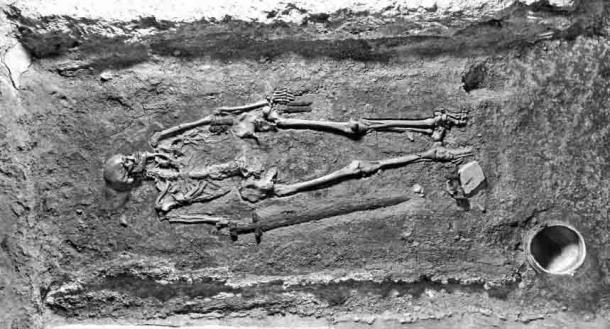Artist Reconstructs Faces of Slavic Warriors Who Survived Nazi Attack
A 1,000-year-old skeleton was unearthed in the bowels of Prague Castle in 1925 and the man’s identity was corrupted by Nazi scientists in 1935. Now, after a DNA study, a 3D artist has reconstructed the faces of two Slavic warriors, “the sons of Ludmila of Bohemia,” a famous 10th century Christian martyr.
After World War I the Austro-Hungarian Empire splintered forming several new countries in Central Europe who all needed their own national histories. In Czechoslovakia, Prague Castle became the seat of the new post–WWI state and in 1925 archaeologists discovered a graveyard within the castle grounds dated, at the time, to between 800 and 1000 AD.
An ancient skeleton was unearthed in the castle cemetery, buried with an ax, two knives, a badly corroded sword, a leather pouch with a fire-striker and a small flint. According to Archaeology, at the time the man was “tentatively” identified as Bořivoj I, or his son Spytihněv I, both of whom were members of the Slavic Přemyslid Dynasty that ruled Prague from the ninth to early fourteenth centuries. However, the man’s actual identity evaded specialists for almost 100 years until archaeologist Nicholas Saunders of the University of Bristol, Jan Frolík of the Czech Academy of Sciences, and Volker Heyd of the University of Helsinki set about solving the mystery in 2019.

Facial reconstruction process of Spytihnĕv I and Vratislav I, the Slavic warriors who faces have been forensically reconstructed using DNA samples. (Cisero Moraes / Naše historie z. s.)
Rebuilding the Facial Expressions of Slavic Warriors
Spytihnĕv I was the Duke of Bohemia from 895 AD until his death in 915 AD at which time Vratislav I, father of Wenceslaus I, better known as “good King Wenceslas,” became the duke. His brother’s remains were unearthed at Prague Castle in the 1980s, and now, using photogrammetry driven virtual 3D models, graphic artist and forensic facial reconstruction expert Cicero André da Costa Moraes has published forensically accurate facial reconstructions of the two warriors.
- Identity of 1000-Year-Old Warrior Corrupted by Nazi and Soviet Spin Doctors
- Was Heinrich Himmler’s 'Nazi Witch Library' Discovered in a Czech Library?
Da Costa Moraes told Radio Prague International that he makes all of his facial reconstruction “without knowing who the person was.” This means his reconstructions are almost free from pre-conceived ideas and influences. The artist said DNA samples were extracted from the man’s bones from which scientists were able to ascertain the men’s eye and hair color. Archaeologist Jan Frolík said the men’s hair and beard styles were based on “educated guesses, according to illustrations in contemporary manuscripts,” but she admits the team don’t really know how the people wore their hair day-to-day.

Photo of grave IIIN199, shortly after excavation in 1928, showing the controversial skeleton of what is now known as being a Slavic warrior. (Institute of Archaeology of the CAS / Prague Castle Excavations)
The Nazi Rewriting of World History
The Bohemian warrior was discovered in Prague Castle in 1925, which was only a decade before the Nazis invaded Czechoslovakia. According to a 2019 BBC article, a team of Nazi scientists in Czechoslovakia seized the warrior’s body in 1935 and accused the archaeologists concerned with its discovery of skeleton of “hiding the man’s true identity.”
- The Myth of National Socialism: How the Nazis Distorted the Nordic Past
- Unearthed Brooch Tells of the Nazis’ Abuse of Ancient Norse Runes to Spread Their Dark Ideology
As part of their rewriting of world history the Nazis announced that the man was “a Viking, not a Slav,” a false narrative that enhanced the emerging Viking, Nordic, and Germanic identity. According to the BBC, it was this rewriting of history that was used to justify the German invasion and occupation of Eastern Europe, “as well as the Nazi extermination of Slavs, Jews, and other populations they deemed inferior.”
With the Germans defeated, the Communist Party ruled over Czechoslovakia after WWI as a satellite state of the U.S.S.R. and the warrior buried in Prague Castle returned to its Slavic status. Once again the Slavic warrior was generally regarded as having been a member of the Přemyslid Dynasty. When the Soviet Union dissolved in 1991, the new state of Czechoslovakia displayed the warrior in Prague Castle symbolically marking the historic beginnings of the ancient Czech state.
Now, having completed his new DNA study of these Slavic warriors, Frolík is turning his attention to saving the identities of several other medieval skeletons excavated in the castle. Maybe by the end of 2021, I will be writing about a new “3D Army” of Slavic warriors emerging from the mind and machines of Jan Frolík.
Top image: A facial reconstruction artist has recreated the faces of two Slavic warriors using DNA samples. Source: (Naše historie z. s.)
By Ashley Cowie




















Comments
Hi Caesar,
Check out this Wiki entry -
https://de.zxc.wiki/wiki/Bo%C5%99ivoj_I.#Tod_und_Grabst%C3%A4tte
which states that the tomb for the Duke remained empty, and a bit of controversy about the presumed remains.
Weep for Europe, our states birthed in lakes of blood.
Srebrenica.
I enjoyed your article; but what I find strange is that there were no grave markers for these skeletonal remains. If they were members of a royal family buried in the family castle with valuable items why no ‘tombstone’ or effigy stating exactly who these men were?